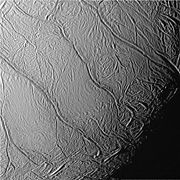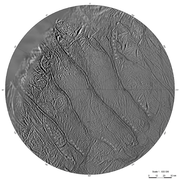
Tiger Stripes (Enceladus)
Encyclopedia

The tiger stripes of Enceladus
Enceladus (moon)
Enceladus is the sixth-largest of the moons of Saturn. It was discovered in 1789 by William Herschel. Until the two Voyager spacecraft passed near it in the early 1980s very little was known about this small moon besides the identification of water ice on its surface...
consist of four sub-parallel, linear depressions in the south polar region of the Saturnian
Saturn
Saturn is the sixth planet from the Sun and the second largest planet in the Solar System, after Jupiter. Saturn is named after the Roman god Saturn, equated to the Greek Cronus , the Babylonian Ninurta and the Hindu Shani. Saturn's astronomical symbol represents the Roman god's sickle.Saturn,...
moon. First observed on May 20, 2005 by the Cassini spacecraft's Imaging Science Sub-system (ISS) camera (though seen obliquely during an early flyby), the features are most notable in lower resolution images by their brightness contrast from the surrounding terrain. Higher resolution observations were obtained by Cassini's various instruments during a close flyby of Enceladus on July 14, 2005. These observations revealed the tiger stripes to be low ridges with a central fracture. Observations from the Composite Infrared Spectrometer (CIRS) instrument showed the tiger stripes to have elevated surface temperatures, indicative of present-day cryovolcanism on Enceladus centered on the tiger stripes.
Names
The name tiger stripes is a unofficial term given to these four features based on their distinctive albedo. Enceladean sulciSulcus (geology)
Sulcus is, in astrogeology, a long parallel groove on a planet or a moon.For example, Uruk Sulcus is a bright region of grooved terrain adjacent to Galileo Regio on Jupiter's moon Ganymede....
(subparallel furrows and ridges), like Samarkand Sulci
Samarkand Sulci
Samarkand Sulci is a region of grooved terrain on the surface of Saturn's moon Enceladus. The feature is centered at 30.5° North Latitude, 326.8° West Longitude and is approximately 383 kilometers long. Samarkand Sulci consists of three parts. The southern and eastern extensions bound Sarandib...
and Harran Sulci
Harran Sulci
Harran Sulci is a region of grooved terrain on the surface of Saturn's moon Enceladus. The feature is centered at 26.7° North Latitude, 237.6° West Longitude and is approximately 276 kilometers long...
, have been named after cities or countries referred to in The Arabian Nights. Accordingly. in November, 2006, the tiger stripes were assigned the official names Alexandria Sulcus, Cairo Sulcus, Baghdad Sulcus and Damascus Sulcus (Camphor Sulcus is a smaller feature that branches off Alexandria Sulcus). Baghdad and Damascus sulci are the most active, while Alexandria Sulcus is the least active.
Appearance and Geology

Lithosphere
The lithosphere is the rigid outermost shell of a rocky planet. On Earth, it comprises the crust and the portion of the upper mantle that behaves elastically on time scales of thousands of years or greater.- Earth's lithosphere :...
. The stripes are spaced approximately 35 kilometers apart. The ends of each tiger stripe differ in appearance between the anti-Saturnian and sub-Saturnian hemisphere. On the anti-Saturnian hemisphere, the stripes terminate in hook-shaped bends, while the sub-Saturnian tips bifurcate dendritically.
Virtually no impact crater
Impact crater
In the broadest sense, the term impact crater can be applied to any depression, natural or manmade, resulting from the high velocity impact of a projectile with a larger body...
s have been found on or near the tiger stripes, suggesting a very young surface age. Surface age estimates based on crater counting yielded an age of 4-100 million years assuming a lunar-like cratering flux and 0.5-1 million years assuming a constant cratering flux.
Composition
Another aspect that distinguishes the tiger stripes from the rest of the surface of Enceladus is its unusual composition. Nearly the entire surface of Enceladus is covered in a blanket of fine-grained water ice. The ridges that surround the tiger stripes are often covered in coarse-grained, crystalline water ice. This material appears dark in the Cassini camera's IR3 filter (central wavelength 930 nanometers), giving the tiger stripes a dark appearance in clear-filter images and a blue-green appearance in false-color, near-ultraviolet, green, near-infrared images. The Visual and Infrared Mapping Spectrometer (VIMS) instrument also detected trapped carbon dioxideCarbon dioxide
Carbon dioxide is a naturally occurring chemical compound composed of two oxygen atoms covalently bonded to a single carbon atom...
ice and simple organics within the tiger stripes. Simple organic material has not been detected anywhere else on the surface of Enceladus.
The detection of crystalline water ice along the tiger stripes also provides an age constraint. Crystalline water ice gradually loses its crystal structure after being cooled and subjected to the Saturnian magnetospheric environment. Such a transformation into finer-grained, amorphous water ice is thought to take a few decades to a thousand years.
Cryovolcanism
Observations by Cassini during the July 14, 2005 flyby revealed a cryovolcanically active region on Enceladus centered on the tiger stripe region. The CIRS instrument revealed the entire tiger stripe region (south of 70° South latitude) to be warmer than expected if the region were heated solely from sunlight. Higher resolution observations revealed that the hottest material near Enceladus' south pole is located within the tiger stripe fractures. Color temperatures between 113-157 kelvinKelvin
The kelvin is a unit of measurement for temperature. It is one of the seven base units in the International System of Units and is assigned the unit symbol K. The Kelvin scale is an absolute, thermodynamic temperature scale using as its null point absolute zero, the temperature at which all...
s have been obtained from the CIRS data, significantly warmer than the expected 68 kelvins for this region of Enceladus.
Data from the ISS, Ion and Neutral Mass Spectrometer (INMS), Cosmic Dust Analyser (CDA) and CIRS instruments show that a plume of water vapor and ice, methane
Methane
Methane is a chemical compound with the chemical formula . It is the simplest alkane, the principal component of natural gas, and probably the most abundant organic compound on earth. The relative abundance of methane makes it an attractive fuel...
, carbon dioxide
Carbon dioxide
Carbon dioxide is a naturally occurring chemical compound composed of two oxygen atoms covalently bonded to a single carbon atom...
, and nitrogen
Nitrogen
Nitrogen is a chemical element that has the symbol N, atomic number of 7 and atomic mass 14.00674 u. Elemental nitrogen is a colorless, odorless, tasteless, and mostly inert diatomic gas at standard conditions, constituting 78.08% by volume of Earth's atmosphere...
emanates from a series of jets located within the tiger stripes. The amount of material within the plume suggests that the plume is generated from a near-surface body of liquid water.
Alternatively, Kieffer et al. (2006) suggest that Enceladus' geyser
Geyser
A geyser is a spring characterized by intermittent discharge of water ejected turbulently and accompanied by a vapour phase . The word geyser comes from Geysir, the name of an erupting spring at Haukadalur, Iceland; that name, in turn, comes from the Icelandic verb geysa, "to gush", the verb...
s originate from clathrate hydrates, where carbon dioxide, methane, and nitrogen are released when exposed to the vacuum of space by the fractures.
External links
- Fountains of Enceladus - Moon of Saturn at Cosmic Secrets

